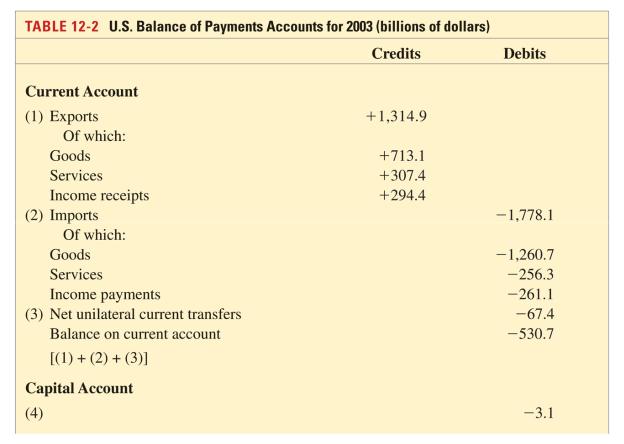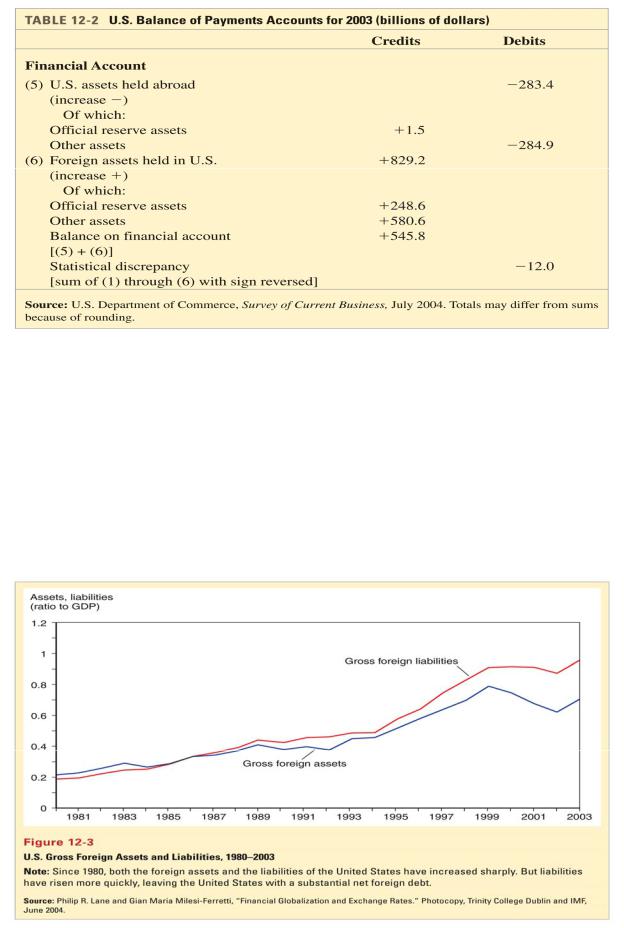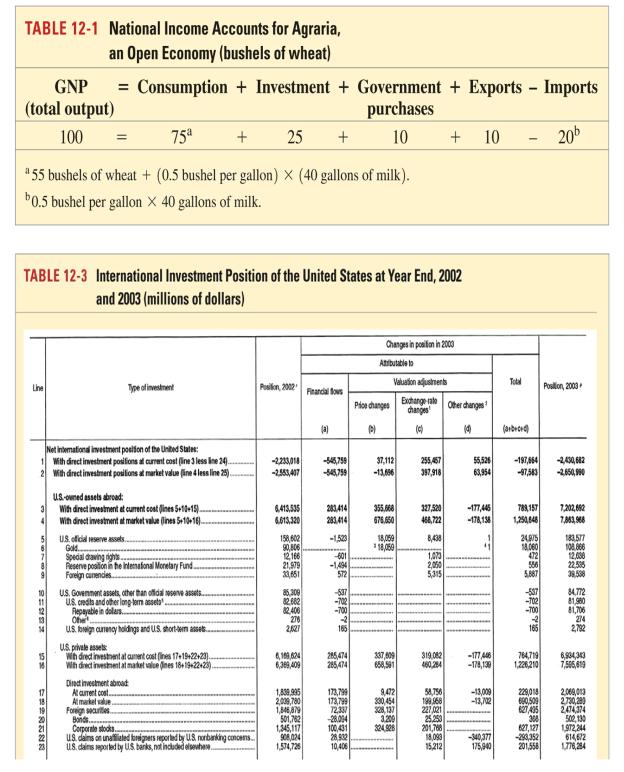
10686
.pdf
•US banks forgive a $100 M debt owed by the government of Argentina through debt restructuring.
US banks who hold the debt thereby reduce the debt by crediting Argentina's bank accounts
Debt forgiveness: non-market transfer (capital account) |
–$100 M |
|
|
Credit (“sale”) of bank account by bank (financial |
+$100 M |
account) |
|
|
|
How Do the Balance of Payments Accounts Balance?
•Due to the double entry of each transaction, the balance of payments accounts will balance by the following equation:
current account + financial account +
capital account = 0
Balance of Payments Accounts
•Each of the 3 broad accounts are more finely divided:
•Current account: imports and exports
1.merchandise (goods like DVDs)
2.services (payments for legal services, shipping services, tourist meals,…)
3.income receipts (interest and dividend payments, earnings of firms and workers operating in foreign countries)
•Current account: net unilateral transfers
1.gifts (transfers) across countries that do not purchase a good or service nor serve as income
•Capital account: records special asset transfers, but this is a minor account for the US.
•Financial account: the difference between sales of domestic assets to foreigners and purchases of foreign assets by domestic citizens.
•Financial (capital) inflow
1.Foreigners loan to domestic citizens by acquiring domestic assets.
2.Foreign owned (sold) assets in the domestic economy are a credit
(+)
•Financial (capital) outflow
1.Domestic citizens loan to foreigners by acquiring foreign assets.
2.Domestically owned (purchased) assets in foreign economies are a debit (-)
•Financial account has at least 3 categories:
1.Official (international) reserve assets
2.All other assets
3.Statistical discrepancy
•Statistical discrepancy
1.Data from a transaction may come from different sources that differ in coverage, accuracy, and timing.
2.The balance of payments accounts therefore seldom balance in practice.
3.The statistical discrepancy is the account added to or subtracted from the financial account to make it balance with the current account and capital account.
•Official (international) reserve assets: foreign assets held by central banks to cushion against instability in international markets.
1.Assets include government bonds, currency, gold and accounts at the International Monetary Fund.
2.Official reserve assets owned by (sold to) foreign central banks are a credit (+).

3.Official reserve assets owned by (purchased by) the domestic central bank are a debit (-).
•The negative value of the official reserve assets is called the official settlements balance or “balance of payments”.
1.It is the sum of the current account, the capital account, the nonreserve portion of the financial account, and the statistical discrepancy.
2.A negative official settlements balance may indicate that a country is depleting its official international reserve assets or may be incurring debts to foreign central banks.
•selling foreign currency by the domestic central bank and buying domestic assets by foreign central banks are credits for official international reserve assets, and therefore reduce the official settlements balance.
US Balance of Payments Accounts, 2003 in Billions of Dollars

US Balance of Payments Accounts
•The US has the most negative net foreign wealth in the world, and so is therefore the world’s largest debtor nation.
•And its current account deficit in 2004 was $670 billion dollars, so that net foreign wealth continued to decrease.
•The value of foreign assets held by the US has grown since 1980, but liabilities of the US (debt held by foreigners) has grown more quickly.
•About 70% of foreign assets held by the US are denominated in foreign currencies and almost all of US liabilities (debt) are denominated in dollars.
•Changes in the exchange rate influence value of net foreign wealth (gross
foreign assets minus gross foreign liabilities).
A depreciation of the US dollar makes foreign assets held by the US more valuable, but does not change the dollar value of dollar denominated debt.
Summary
1.A country’s GNP is roughly equal to the income received by its factors of production.
2.In an open economy, GNP equals the sum of consumption, investment, government purchases, and the current account.
3.GDP is equal to GNP minus net receipts of factor income from abroad. It measures the output produced within a country’s borders.
4.National saving minus domestic investment equals the current account (≈ exports minus imports).
5.The current account equals the country’s net foreign investment (net outflows of financial assets).
6.The balance of payments accounts records flows of goods & services and flows of financial assets across countries.
1.It has 3 parts: current account, capital account and financial account, which balance each other.
2.Transactions of goods and services appear in the current account; transactions of financial assets appear in the financial account.
7.Official international reserve assets are a component of the financial account which records official assets held by central banks.
8.The official settlements balance is the negative value of official international reserve assets, and it shows a central bank’s holdings of

foreign assets relative to foreign central banks’ holdings of domestic assets.
9.The US is the largest debtor nation, and its foreign debt continues to grow because its current account continues to be negative.

Chapter 13
Exchange Rates and the Foreign Exchange Market: An Asset
Approach
Preview
•The basics of exchange rates
•Exchange rates and the prices of goods
•The foreign exchange markets
•The demand for currency and other assets
•A model of foreign exchange markets
role of interest rates on currency deposits
role of expectations about the exchange rates
Definitions of Exchange Rates
•Exchange rates are quoted as foreign currency per unit of domestic currency or domestic currency per unit of foreign currency.
How much can be exchanged for one dollar? ¥102/$1
How much can be exchanged for one yen? $0.0098/¥1
•Exchange rate allow us to denominate the cost or price of a good or service in a common currency.
How much does a Honda cost? ¥3,000,000
Or, ¥3,000,000 x $0.0098/¥1 = $29,400
Depreciation and Appreciation
•Depreciation is a decrease in the value of a currency relative to another currency.
A depreciated currency is less valuable (less expensive) and therefore can be exchanged for (can buy) a smaller amount of foreign currency.
$1/€1 ! $1.20/€1 means that the dollar has depreciated relative to
the euro. It now takes $1.20 to buy one euro, so that the dollar is less valuable.
The |
euro |
has |
appreciated |
relative |
to |
the |
dollar: |
it is now more valuable.
•Appreciation is an increase in the value of a currency relative to another currency.
An appreciated currency is more valuable (more expensive) and therefore can be exchanged for (can buy) a larger amount of foreign currency.
$1/€1 ! $0.90/€1 means that the dollar has appreciated relative to the euro. It now takes only $0.90 to buy one euro, so that the dollar is more valuable.
The euro has depreciated relative to the dollar: it is now less valuable.
•A depreciated currency is less valuable, and therefore it can buy fewer foreign produced goods that are denominated in foreign currency.
How much does a Honda cost? ¥3,000,000
¥3,000,000 x $0.0098/¥1 = $29,400
¥3,000,000 x $0.0100/¥1 = $30,000
•A depreciated currency means that imports are more expensive and domestically produced goods and exports are less expensive.
•A depreciated currency lowers the price of exports relative to the price of imports.
•An appreciated currency is more valuable, and therefore it can buy more foreign produced goods that are denominated in foreign currency.
How much does a Honda cost? ¥3,000,000
¥3,000,000 x $0.0098/¥1 = $29,400
¥3,000,000 x $0.0090/¥1 = $27,000
•An appreciated currency means that imports are less expensive and domestically produced goods and exports are more expensive.
•An appreciated currency raises the price of exports relative to the price of imports.
The Foreign Exchange Market
The participants:
1.Commercial banks and other depository institutions: transactions involve buying/selling of bank deposits in different currencies for investment.
2.Non bank financial institutions (pension funds, insurance funds) may buy/sell foreign assets.
3.Private firms: conduct foreign currency transactions to buy/sell goods, assets or services.
4.Central banks: conduct official international reserves transactions.
5.Buying and selling in the foreign exchange market are dominated by commercial banks.
1.Inter-bank transactions of deposits in foreign currencies occur in amounts $1 million or more per transaction.
2.Central banks sometimes intervene, but the direct effects of their transactions are usually small and transitory.
Characteristics of the market:
•Trading occurs mostly in major financial cities: London, New York, Tokyo, Frankfurt, Singapore.
•The volume of foreign exchange has grown:
in 1989 the daily volume of trading was $600 billion, in 2001 the daily volume of trading was $1.2 trillion.
•About 90% of transactions in 2001 involved US dollars.
•Computers transmit information rapidly and have integrated markets.
•The integration of markets implies that there is no significant arbitrage between markets.
if dollars are cheaper in New York than in London, people will buy them in New York and stop buying them in London. The price of dollars in New York rises and the price of dollars in London falls, until the prices in the two markets are equal.
•Spot rates are exchange rates for currency exchanges “on the spot”, or when trading is executed in the present.
•Forward rates are exchange rates for currency exchanges that will occur at a future (“forward”) date.
